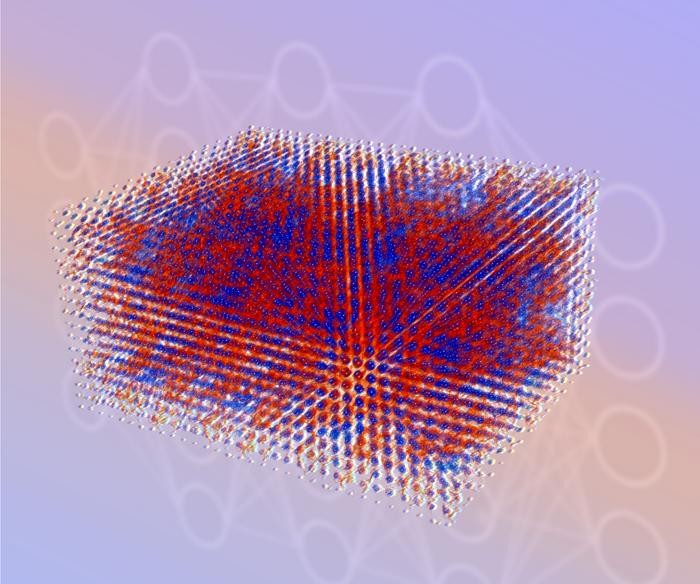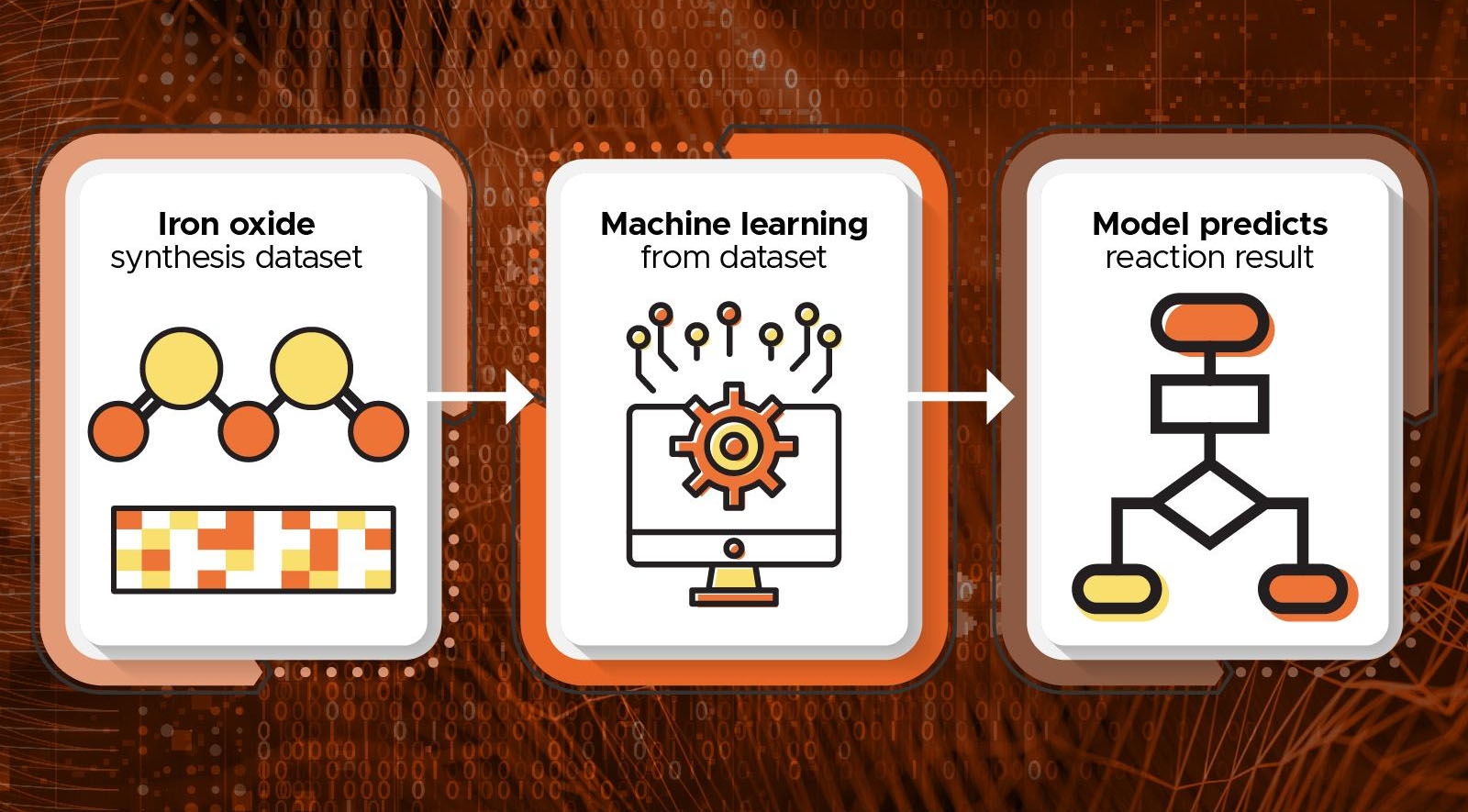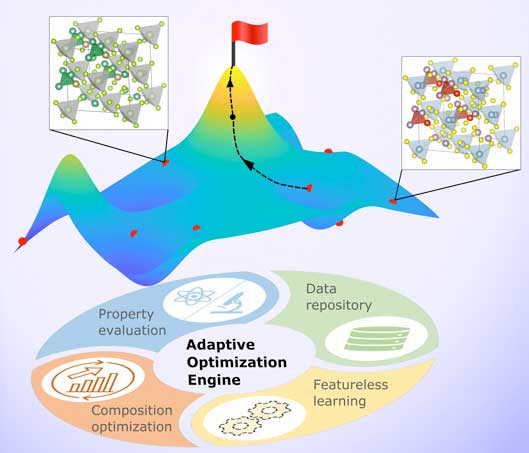| Feb 29, 2024 | |
Machine learning innovations and applications in nanotechnology |
|
| (Nanowerk Spotlight) Machine Learning in nanotechnology represents a vibrant fusion of artificial intelligence (AI) with the manipulation, design, and application of materials, devices, and systems at the nanoscale. This integration of machine learning (ML) within nanotechnology promises to significantly expedite the processes of discovery and innovation, offering novel methodologies for analyzing data and designing materials. | |
| Machine learning, with its ability to analyze large datasets and identify patterns, is particularly well-suited to address the challenges presented by the vast and complex data generated in nanoscience. | |
What is Machine Learning? |
|
| Machine learning is a fascinating area of artificial intelligence that gives computers the ability to learn and improve from experience without being explicitly programmed for specific tasks. Think of it like teaching a child to recognize different types of fruit. You show them several examples of apples and bananas, and over time, they learn to distinguish between the two. | |
| Similarly, in machine learning, a computer system is fed a large amount of data, which could be anything from images to numbers to words. The system then uses this data to learn patterns and make predictions or decisions. For instance, when you shop online, machine learning helps recommend products you might like based on your browsing history. Or when you speak to a virtual assistant like Siri, Alexa, or one of the newer AI chatbots, machine learning is what helps them understand your speech and respond appropriately. | |
| It's also used in more complex tasks like helping doctors diagnose diseases based on medical images or enabling cars to drive themselves by processing and reacting to their surroundings. At its core, machine learning involves algorithms, which are sets of rules or instructions that the computer follows to analyze the data and learn from it. These algorithms can improve their performance as they are exposed to more data over time. This process is similar to how humans learn from experience, hence the term 'machine learning'. | |
 |
|
| Snapshot of a deep learning simulation of more than 10,000 beryllium atoms. The distribution of electrons in this material is visualized as red (delocalized electrons) and blue (electrons located close to the atomic nuclei) point clouds. This simulation is not feasible using conventional DFT calculation. Read more. (Image: HZDR / CASUS) | |
Applications of Machine Learning in Nanotechnology |
|
| In the context of nanotechnology, ML algorithms process and analyze vast amounts of data from experimental, theoretical, and computational studies. This analysis helps in the discovery of new nanomaterials, understanding their properties, and optimizing nanofabrication processes. The predictive power of ML models transforms how scientists and engineers approach challenges in nanotechnology, enabling more efficient research and development. | |
| In the following, we list several key application areas with examples of published research in the field: | |
Analysis of Nanomaterials |
|
| Machine learning algorithms excel at deciphering the complex datasets associated with nanomaterials. They can unravel hidden correlations and patterns, shedding light on the intricate properties and behaviors of these materials. For example, ML techniques can predict thermal conductivity and mechanical strength by analyzing atomic configurations and bonding patterns. This insight is crucial for designing materials for specific applications, such as heat-resistant coatings or lightweight, high-strength composites. | |
| For example, researchers from Zhejiang University have developed a machine learning framework using generative adversarial networks (GANs) to predict structural and physical changes in graphene under strain, a method that could revolutionize the design of 2D materials for applications in electronics and quantum computing. | |
| This approach, which can rapidly predict how strains affect atomic structures and physical properties, has been trained on thousands of examples, demonstrating the potential for significant acceleration in the discovery and optimization of new materials. The methodology, while focused on graphene, is adaptable to other 2D materials and possibly to 3D bulk crystals, promising advancements in flexible electronics, smart mechanical devices, and reprogrammable metamaterials through efficient high-throughput material screening. | |
| In another example, researchers at Aalto University and the University of Luxembourg have developed a new machine learning model that significantly enhances the identification of small molecules, crucial for advancements in medicine, drug discovery, and environmental chemistry. This model, trained on data from numerous laboratories, stands out for its accuracy in distinguishing small molecules, including their stereochemical variants, which has major implications for understanding metabolic disorders, cancer research, and the design of new drugs. By focusing on the stable retention order of molecules across different labs, the model overcomes traditional challenges in comparing data, offering a groundbreaking tool for the scientific community. | |
Design and Discovery of New Nanomaterials |
|
| ML is revolutionizing the way new nanomaterials are discovered and designed. By predicting the electronic, mechanical, and thermal properties of hypothetical materials, machine learning in materials design guides researchers towards novel materials with desired functionalities. This predictive capability is instrumental in developing next-generation batteries, supercapacitors, and photovoltaic materials, where efficiency and performance are paramount. | |
| For example, scientists at Pacific Northwest National Laboratory have developed a machine learning method to accurately predict and control the synthesis of iron oxide nanoparticles, overcoming traditional challenges in particle size and crystalline phase control. This approach leverages algorithms to forecast synthesis outcomes and optimize parameters for desired nanoparticle characteristics, achieving high accuracy in predicting particle phase and size. The research represents a significant step towards more efficient and targeted materials synthesis, promising accelerated development of iron oxides for applications of nanomaterials in energy storage, biomedicine, and catalysis. | |
 |
|
| A machine learning model can predict potential outcomes for different reaction conditions in the synthesis of iron oxide particles. (Image: Xin Zhang and Stephanie King | Pacific Northwest National Laboratory) | |
| In another example, researchers at Tohoku University and Shanghai Jiao Tong University have developed a machine learning approach that predicts the growth of carbon nanostructures on metal surfaces, potentially simplifying the design and synthesis of these materials for various applications. This method enables a better understanding and control of the atomic-level dynamics of carbon crystalline growth, offering new possibilities for advancements in electronics and energy devices. | |
Enhanced Imaging, Characterization and Sensing |
|
| In the realm of nanoscale imaging, ML enhances the resolution and accuracy of techniques like electron microscopy and >scanning probe microscopy. By automating the analysis of imaging data, ML algorithms can identify features and patterns at resolutions previously unattainable. This capability is vital for understanding the structural defects in materials and their effects on properties, enabling the design of materials with optimized performance for electronics, catalysis, and more. | |
| Han et al. (2020) present a compelling case study on the use of deep learning for the optical characterization of 2D materials: Advanced Materials, "Deep‐Learning‐Enabled Fast Optical Identification and Characterization of 2D Materials". | |
| In another example, University of Bristol researchers have significantly advanced the >detection of magnetic fields at room temperature by integrating machine learning with a quantum sensor based on the electron spin in nitrogen-vacancy centers in diamonds. This breakthrough, detailed in Physical Review X, heralds the potential for developing advanced MRI scanners and opens new avenues for applications in biology and material science, overcoming traditional limitations through enhanced sensitivity and real-time tracking capabilities. | |
Process Optimization |
|
| ML models streamline the optimization of nanofabrication processes, from chemical synthesis to deposition techniques. They predict the outcomes of process variations, allowing for the fine-tuning of parameters to achieve the desired material quality and characteristics with minimal waste and energy consumption. This optimization is key in scaling up the production of nanomaterials for commercial applications while maintaining sustainability and efficiency. | |
| For instance, Northwestern University researchers have introduced a >novel computational method to speed up the creation of materials capable of metal-insulator transitions (MIT), crucial for developing quicker microelectronics and quantum information systems. This approach utilizes a mix of statistical inference, optimization theory, and computational materials physics to optimize features in complex lacunar spinels, a specific MIT material. | |
 |
|
| Illustration of the approach. (Image: Northwestern University) | |
| Their method, distinct for its use of a small dataset to predict and explore material properties without the need for extensive data or predefined features, has identified 12 new compositions of MIT materials with potential applications in future technologies. Published in Applied Physics Review, this work showcases a significant step forward in materials design, leveraging machine learning to navigate the challenges of limited data availability and demonstrating the broader applicability of their technique beyond inorganic materials to potentially include biomaterials and polymers. | |
Environmental Remediation |
|
| One of the most pressing global challenges is environmental pollution. Here, ML and nanotechnology converge to offer innovative solutions. Nanoparticles, designed with the assistance of machine learning algorithms, can target and neutralize pollutants at the molecular level. This application has the potential to revolutionize environmental cleanup tasks by creating materials that can efficiently remove toxins from water, air, and soil. For instance, ML can predict the optimal configuration of nanoparticles for absorbing specific contaminants, thereby enhancing the effectiveness and efficiency of environmental remediation efforts. Bai et al. (2017) advocated for systematic modification of physicochemical properties of nanoparticles coupled with computational analysis to better understand nano-bio interactions, relevant for environmental remediation efforts. (Toxicology and Applied Pharmacology, "Toward a systematic exploration of nano-bio interactions") | |
Advanced Electronics | |
| The demand for flexible and high-performance electronics is growing, driven by advancements in wearable technology, foldable displays, and IoT devices. Machine learning aids in the discovery and design of nanomaterials with tailored electrical, optical, and mechanical properties to meet these demands. By predicting the performance of materials under various conditions, ML enables the customization of nanomaterials for specific electronic applications, such as ultra-thin sensors, flexible solar panels, and energy-efficient >transistors. This application of ML not only accelerates the material design process but also opens up new possibilities for electronics that are currently unimaginable. | |
| Zhou et al. (2019) reviewed the implementation of machine learning in dealing with light-matter interaction, which is pivotal for developing advanced electronic devices. The study highlights the role of machine learning in accelerating technology development and boosting scientific innovation in photonics technologies, which are crucial for advanced electronics. (Light, Science & Applications, " Emerging role of machine learning in light-matter interaction") | |
Biomedical Innovations |
|
| ML-driven nanotechnology is at the forefront of biomedical innovations, from targeted drug delivery systems to advanced diagnostic tools. By analyzing biological data, ML algorithms can design nanoparticles that specifically target diseased cells, minimizing side effects and improving treatment efficacy. Similarly, in diagnostics, ML can enhance the sensitivity and specificity of nanosensors, enabling early detection of diseases at the molecular level. Boulogeorgos et al. (2020) reviewed the use of ML in nano-scale biomedical engineering, emphasizing its role in accelerating material and structure discoveries and supporting nano-scale communications and networks. (IEEE Transactions on Molecular, Biological and Multi-Scale, "Machine Learning in Nano-Scale Biomedical Engineering") | |
Nanoplasmonics and Optoelectronic Properties |
|
| In >nanoplasmonics, ML algorithms tailor the synthesis of materials to exhibit specific optoelectronic properties, crucial for developing cutting-edge sensors and photonic devices. By modeling the interactions between light and nanostructured materials, ML predicts the plasmonic behavior that leads to enhanced light absorption, scattering, and emission. These insights facilitate the creation of materials for energy-efficient lighting, photonic circuits, and solar cells, pushing the boundaries of what's possible in optoelectronics and communication technologies. | |
| The engineering of >nanophotonic devices involves navigating a complex design space defined by materials, geometry, and illumination conditions, where machine learning has emerged as a vital tool for identifying optimal designs. Professor Yuebing Zheng and his team at the University of Texas at Austin have introduced a >mixture density network approach, modeling design parameters as probability distributions to effectively address the challenge of non-uniqueness in device responses, demonstrating its applicability in designing advanced nanophotonic structures with enhanced accuracy and potential for wide-ranging applications. | |
Quantum Computing |
|
| Machine learning's integration into quantum computing represents a frontier in both computational power and nanoscale precision. By optimizing quantum simulations, ML facilitates the modeling of complex nanoscale systems with unparalleled accuracy. This synergy could accelerate the development of quantum algorithms and devices, enabling researchers to solve problems in chemistry, physics, and materials science that are currently beyond the reach of classical computers. Quantum computing, powered by ML, holds the promise of discovering new states of matter and quantum materials with novel properties. | |
| Carleo et al. (2019) examined the interface between ML and the physical sciences, including quantum computing, highlighting ML's role in optimizing quantum simulations and facilitating the modeling of complex nanoscale systems. (Reviews of Modern Physics, "Machine learning and the physical sciences") | |
Integrating These Advances |
|
| Each of these applications demonstrates the transformative potential of combining machine learning with nanotechnology. From quantum computing to environmental remediation and advanced electronics, ML empowers scientists and engineers to explore the nanoworld with enhanced precision and creativity. As ML models become more sophisticated and data from nanotechnological experiments grow more abundant, the possibilities for innovation and discovery continue to expand. | |
| The future of nanotechnology, powered by machine learning, promises to bring about solutions to some of the world's most complex challenges while opening up new avenues for technological advancement. | |
| The integration of machine learning into nanotechnology is not just about enhancing existing processes; it's about reimagining what's possible in science and engineering. This synergy enables the design of smarter nanoparticles for environmental cleanup, more effective drugs for targeted therapy, and materials with previously unimaginable properties for electronics and energy storage. It allows us to not only see the invisible but also to predict and manipulate it in ways that were previously beyond our imagination. | |
Challenges and Prospects of Integrating Machine Learning with Nanotechnology |
|
| While the integration of machine learning (ML) with nanotechnology heralds a new dawn of scientific discovery and technological innovation, it brings forth a complex array of challenges that demand careful consideration. | |
| Data Complexity and Volume: The sheer complexity and volume of data generated in nanotechnology research pose significant challenges for ML models. Nanoscale phenomena are governed by quantum mechanics, resulting in data that is not only vast but also highly complex. Developing ML algorithms capable of navigating this complexity to make accurate predictions requires advanced data analytics and model training techniques. | |
| Bridging Computational Predictions with Experimental Results: One of the most significant hurdles is the development of ML models that can effectively bridge the gap between computational predictions and real-world experimental results. The predictive models must be robust enough to account for the unpredictability and variability inherent in nanoscale experiments. | |
| Ethical and Environmental Considerations: As we push the boundaries of what's possible with nanotechnology, ethical and environmental considerations become increasingly important. The development of new nanomaterials raises questions about their long-term environmental impact and potential health risks. Rigorous testing and regulation are essential to ensure that these innovations do not pose unforeseen threats to health or the environment. | |
| Interdisciplinary Collaboration Challenges: The interdisciplinary nature of integrating ML with nanotechnology requires collaboration across diverse fields such as chemistry, physics, computer science, and engineering. This collaboration can be hampered by differences in terminology, methodology, and research culture, making effective communication and cooperation essential but challenging. | |
| In conclusion, while integrating ML with nanotechnology presents a myriad of challenges, from data complexity to ethical concerns, the prospects it offers are equally vast. By addressing these challenges head-on and fostering interdisciplinary collaboration, we can unlock the full potential of this exciting convergence, leading to groundbreaking advancements that could redefine the future of technology and medicine. | |
 By
Michael
Berger
– Michael is author of three books by the Royal Society of Chemistry:
Nano-Society: Pushing the Boundaries of Technology,
Nanotechnology: The Future is Tiny, and
Nanoengineering: The Skills and Tools Making Technology Invisible
Copyright ©
Nanowerk LLC
By
Michael
Berger
– Michael is author of three books by the Royal Society of Chemistry:
Nano-Society: Pushing the Boundaries of Technology,
Nanotechnology: The Future is Tiny, and
Nanoengineering: The Skills and Tools Making Technology Invisible
Copyright ©
Nanowerk LLC
|
|
|
Become a Spotlight guest author! Join our large and growing group of guest contributors. Have you just published a scientific paper or have other exciting developments to share with the nanotechnology community? Here is how to publish on nanowerk.com. |
|
